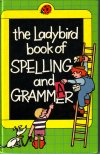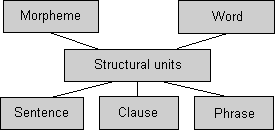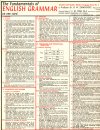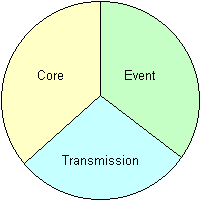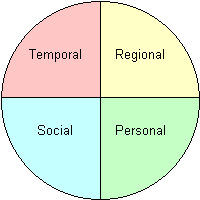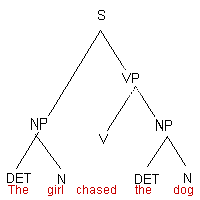 |
Modelling language |
IntroductionI have written this guide for students who are following GCE Advanced level (AS and A2) syllabuses in English Language. This resource may also be of general interest to language students on university degree courses, trainee teachers and anyone with a general interest in language science. On this page I use red type for emphasis. Brown type is used where italics would appear in print (in this screen font, italic looks like this, and is unkind on most readers). Finally, main section headings look like thisModels are everywhereAlmost any book that teaches about language will use some kind of model to represent the teaching to the reader. Here is a simple example - Dorothy Paull's excellent Ladybird Book of Spelling and Grammar. But it's not that simple - this book contains things from which even quite sophisticated students and teachers can learn. The book is organized into:
Behind this set of contents lies an idea of what are the important things for people learning about language - to know how it works (grammar) and to be able to use standard forms (spelling and punctuation). You might like to think about where, if anywhere, the subjects in the list above would fit into the course you may be studying. Sometimes the names would be different - so where the Ladybird book refers to "derivations" you might know these as "loan words", within the subject of etymology, which is a part of the study of the lexicon. But you would see a balance between knowing things (so that you can understand the underlying theory) and being able to use language in appropriate ways, including using standard written forms. What are models?Models are representations of things that are (usually) complex. (If they are very simple, we may understand them without a model.) We use models to help us make sense of the complex reality, or attend only to those features of it that are of interest to our present enquiry. You are probably familiar with many models from all sorts of academic subjects that you have studied at school. For example, the following diagram shows a simple model of the molecular structure of water.
And models for long protein molecules are almost impossible for many of us to understand. Note that these models for water concentrate on a few things (the proportion of hydrogen to oxygen atoms and the atomic links) and ignore everything else - such as the physical properties of water, its states of matter at different temperatures and pressures, its value to organic life-forms, and so on. As a student of language, you cannot make much progress without using models. In fact, it is almost impossible for your teacher to get by without models. How appropriate these are is another matter. And they may not correspond very accurately to the reality they seek to represent. In fact, they can be positively misleading. For example, you may sometimes be asked to analyse sentences in terms of their clause structure, then phrases within clauses, then the sequence of words in phrases, and finally the morphology of individual words. This is fine, so long as you do not reverse the process as a means of generating your own sentences (except as an experiment in finding out its impracticality). You do not speak or write by selecting a root, adding prefixes or suffixes, to build up whole words, then arrange them into phrases, then clauses and finally sentences. The way in which real people (children and adults) generate sentences is the subject of a special branch of study, and our knowledge of it is not at all complete - but we do know that some past theories are mistaken. Models need not be one or two-dimensional - I might create an animated sequence as a model of something to do with language. And for some things (like language change) this would make sense, as the model would share with its subject the quality of change over time - except that I would massively reduce the timescale and the content. Here are a few models for you to look at.
The model is also dangerous because one might believe that morpheme, word, phrase, clause and sentence are fundamental and universal features of all natural languages, and that all languages organize them in the ways we know from English or other European languages. But these things are not true, or not wholly true. (Morphemes probably are fundamental and universal in natural human languages. But beyond this there are great variations in the ways in which we may combine them.)
In this much-reduced thumbnail version, you cannot easily read anything beyond the title (The Fundamentals of English Grammar). The red headings correspond to word categories or parts of speech.
Unlike the hierarchical model of structure, this model does correspond quite closely to what really happens - we do (in our speaking as in our writing) often adapt a root adjective form with an “-er” ending or by prefacing it with “more”. (In speaking we would normally be more tolerant of using either form, whereas in writing we might take time to select the more appropriate one, if this were not obvious to us.) Are models the same as diagrams?No, they are not - but for convenience we sometimes confuse the two. It is tedious to repeat that this diagram “represents” a particular model, rather than is it - but as the example of water shows, we may have different diagrams to depict the same model. Diagrams and mental modelsIn trying to understand a subject, you will perhaps wish to learn models in the sense that you can recall them when you need to organize your ideas. Sometimes you may wish to learn a sequence of words or statements, while at other times you may wish to learn a particular diagram or other pictorial representation. You can, of course, attempt to do this in a time of revision, but it is much more easy to do, if you have been looking at the model or diagram for a longer time. How can you do this? By making posters for your classroom or smaller diagrams to display in the room where you normally study at home. A clever author may help you to learn a model by including it in the title of a book, as Shirley Russell has done with Grammar, Structure and Style. (For some kinds of assessed task, this three-part structure will help you to have a basic sense of what to do - but there is a limit to how much you can teach by making it the title of a book. For an example outside of language study, think of John Gray's Men Are from Mars, Women Are from Venus.) It makes sense for you to use diagrams that fit the way you think - they can be more verbal and linear or more pictorial and even colourful, while still representing the same basic model. As a teacher, I would often give a rudimentary diagram from a textbook to a student whom I knew to be a gifted artist, and ask him or her to turn it into a bigger and more visually appealing version for display in the teaching room. I would place the resulting poster behind my teaching area, so that over time students would come to know it - and perhaps make use of it in exams. A very familiar way to recall models is to reduce them to mnemonics, such as acronyms. John Shuttleworth (writing in e-magazine) commends a model for analysing unfamiliar texts:
Mr. Shuttleworth reduces this to the acronym SPAG ICE. It is of no use, of course, unless the student who learns it can expand the seven headings into a more detailed procedure. Moreover, John Shuttleworth suggests putting example before comment - but notes that this would not yield such a good mnemonic. It is a wholly appropriate model for GCE students because it lists things that the examiners have already (in writing the syllabus) identified as being important. It would be unsuitable for an academic linguist, perhaps, because it is essentially reductive - if we stick to this list we will never consider other approaches to analysis, but will become better and better at ploughing these particular furrows. (That is, the list is a model of a conventional method, rather than of universal truths about what texts are. An intelligent Martian, with another value system, might ask very different questions about a text.) Models for academic linguistsI am not an academic linguist (one of the roads not taken earlier in life), and I may begin to look foolish if I pretend to know in detail the models that would underlie, say, a higher degree in general linguistics or in some specialized field, such as sociolinguistics. One way to find out, is to look at the syllabus or course-components for first and higher degrees - you may see these in university prospectuses in print or on a Web site. You quite possibly already have some prospectuses - see what they tell you. You may not know what all the names of different parts of a course mean - but at least you will see some things about which you could find out more. A better way might be to look at the content of an encyclopaedic work - and fortunately there are some good examples available to you. Professor David Crystal is probably the most distinguished living linguist who has a general command of the subject (he does also specialize in particular areas of study). The contents of his reference books provide a kind of model - “kind of”, because print publication may impose some constraints on his abstract understanding of theory. Books are linear and something has to come first. Professor Crystal alerts the reader to this, in his Cambridge Encyclopaedia of the English Language. The first pages of this book show us two models. One is a model of structure, the other of use. The models are presented as diagrams, containing headings, which are amplified in further text. That is, without the explanatory gloss, the diagram does not give the complete model.
I have not reproduced Professor Crystal's copyrighted diagrams - they are heavily stylized and appear to be projected from the twin mouths of Janus on a Roman coin (a mild distraction from the models of use and structure). Other models can be inferred from the contents of language textbooks. Note that some writers will deliberately restrict themselves to a given area of study, such as history and language change (Robert McCrum's The Story of English) or stylistics (G. W. Turner's Stylistics). Here are some examples. David Crystal's Encyclopedia of Language has these eleven section headings:
In the same author's Cambridge Encyclopedia of the English Language we find a six-part structure (or seven, counting the preface):
In both cases, these are further broken down into chapters. For example, Part III of The Cambridge Encyclopedia of the English Language has:
In turn, Chapter 14 (The Structure of Words) divides into these sections:
Professor Whitney F. Bolton's The English Language (Sphere History of Literature in the English Language, Vol. 10) has these section headings:
Is it fair to think of these as models? They may not be the abstract models the authors use for their own thinking about language. But it does seem fair to see them as the authors' models for presenting the subject to their readers in a linear form. You can see many other models by looking at textbooks for yourself. Do this individually and with friends - ask your teachers to help you find examples. Discuss how good the models are at helping you see things, and how good they are (if you are able to judge this) at representing some part of language theory appropriately. If you think this is hard, spare a thought for students of language in the ancient world, who would be expected to hold all this in their minds - and to learn almost wholly by speaking and listening. (They would be literate but would not usually do their own writing - instead they would dictate to an amanuensis, or scribe.) Historical and contemporary modelsIf we go back in time to look at the models for studying language we may find that these are very different from what linguists study today - or rather, we may find
This is not the same as noting that ideas within an area of study have changed. So grammar remains an essential concept - but our ideas of what it is, where it comes from and how it works have altered quite radically. We can also say that models have become more scientific - that is, that language study is no longer dominated by those who advocate it as a means of social control or point of etiquette. Instead, we find that linguists methodically observe and record what happens and interpret it logically. This observation is often quantitative and objective. The interpretation uses agreed methods that other linguists can replicate in their own studies. And linguists share much common ground with other kinds of scientist who study human mental processes - psychologists, anthropologists, philosophers, paediatricians and sociologists. If we take an area of theory within general linguistics (say, pragmatics) or a particular development within that field (say, speech-act theory), then we may find that it has appeared only in the last half-century. This does not mean that people suddenly started to use speech acts some time in the 20th century. But it does mean that this particular way of explaining what people have done for thousands of years is a recent development. Or take Geoff Leech's Politeness Principle. We know that for courtiers in the 17th century there were rules both implicit and explicit about how to give and receive politeness. George Herbert (1593-1633) makes this clear in his poem, The Pearl: “I know the wayes of honour, what maintains What Geoff Leech has done is to give a structured and coherent account, proposing names for some kinds of interaction. I could suggest that Leech's theory is useful but perhaps flawed, as there is no sincerity maxim - so I could practise his six maxims hypocritically, without meaning a word I say. But this is exactly why Geoff Leech's account is a good scientific model - because it is offered to all language students, who can, over time, add to, or qualify, the maxims. Perhaps students have proposed other maxims and either made the case for them, or seen why they are not appropriate to the theory - in which case I could see if my proposed sincerity maxim had already been tried and found wanting, or deserves serious attention from pragmatics scholars. Models for studentsStudents in secondary schools may have an interest in seeing language theory whole - which you can easily do by having a copy of one of Professor Crystal's encyclopaedic works. You will realize almost at once that perhaps the whole of one's life, let alone a few months of study at school, would be too short to learn about every part of linguistics. Language teachers and examiners devise courses, both for schools and universities, which are very selective. They make decisions about what parts of this huge subject are both important and suitable for you to study. At the same time, they must find ways to measure your knowledge, abilities and understanding - which is not something that the authors of reference books usually set out to do. (The same people may, however, publish the reference books on Monday, write an exam paper on Tuesday, teach you on Wednesday, examine you on Thursday and mark your work on Friday, or something similar with a different time scale.) If your interest in modelling language is wholly about success in exams, then things become simpler and quite straightforward. You can work out models that more or less mirror the exam course. At the highest level, the model is the course structure - and it may be that discrete modules keep wholly in one area of study, so that the course as it appears to you sorts out language study into clear categories. But at the next level down, there is the model of what you do within a particular part of the course, and the assessment activity (say an exam or written coursework) that is associated with it. Examiners will usually suggest this to you in the guidance that accompanies particular tasks, while teachers should give it for coursework. (Most exam boards back this up by publishing guides and notes for teachers.) Here is an example which you may have seen already or may be about to see. “In your answer you should refer to any relevant research and also make use of some of the following frameworks, where appropriate: These exam board models may be slightly artificial - for example creating a module for study called Language Development, which embraces child language acquisition and historic language change, which have little in common, and which would not be grouped in this way in a reference work (except, of course, in a reference work written explicitly to help students taking this exam). Below is a simple three part model represented as a list of bullet points. It comes from the three assessed modules of a GCE course that concern areas of language theory. (The other three modules are presented in terms of tasks without specific content.) These are:
The AQA syllabus A guidance for the module called Introduction to the Study of Language also provides two models. One is in terms of variation (it omits temporal variation, which appears in Professor Crystal's model - because the examiners have left this for the language development part of the course). “Three related concepts form the basis of study for this module. The other is a model of some of the ways in which we can explore and describe language data. They are not really comparable groups (like apples, oranges and pears) but different concepts that apply to the same data. If this seems hard to understand think how easily you can distinguish, say, the workings of a car's engine (grammar) from the different actions a driver can make (lexis) and how its movement is affected by the presence of other vehicles (pragmatics). This is not an exact analogy - but a loose way of showing that we see quite different things in the same data, according to our purpose. Examiners want to know that you can see them all, but in real-world linguistics, you might focus on one only. “The following descriptions of language will enable students to identify and discuss both the language system and its diverse uses and expressions. Investigating language - using modelsUsing models is helpful (perhaps necessary) when you are investigating language. You can use them to illustrate some ideas or theory about which you want to find out more - that is, in explaining a specific area of theory, the task you hope to undertake or your research methods. And when you have collected evidence (language data of some kind), you should use models to present your analysis. This short guide is not the place to expand this - but you may, for example, want to learn more about how you can use charts to show things that you have recorded in tables, using spreadsheet software. Finding examples of modelsThis is easy but is a very useful task. Look at one or more reference books that set out to teach language. Start by reading the contents.
You ought to have seen (ideally to have your own copy - and you can find one online) the syllabus for your course of study. Can you match the parts of the reference book to your course - on your own, or with help from a teacher? If you want to find a syllabus, go to my guide to English language exams by clicking on the link below. Next look within a section or chapter. Try to skim or speed read, while noting what appear to be significant headings. A good author (or an author with a good editor) should use headings consistently to indicate the importance of a subject. You may not, however, have noticed this. Look again and work out what kinds of heading style correspond to what level of importance - now try to get an outline of the current section or chapter. You can take this further by looking at the same subject in different text books - say language and gender or language change.
In creating your own model you may wish to take things from more than one source, or to keep to one that makes sense for you, with perhaps a few additions from others. For example, in drafting guides for this site on pragmatics or language and gender, my first task was to look at other writers' and teachers' approaches and to list their headings. Next I threw these into the air and watched how they settled - well not quite: I rearranged them, keeping some things and putting others into a quite different order. My version has the order I think most satisfactory. But because it is an electronic text with hyperlinked headings, the reader (that's you) can move through it in more or less any order. (You can do this with a print text, but it is not as easy - and it seems to encourage you to take it in sequence. With a novel reading in sequence makes sense. With a reference work it is rarely a sensible thing to do. You need to get used to changing the order of things, as you will certainly do this in your own coursework and in exams.) Move down a further step - and look for diagrams or other kinds of models on particular pages. The diagrams are easy to spot - they tend to be labelled Figure 2: classes of nouns or Table 3: consonant combinations. But sometimes models are lurking in the text of a sentence. You may wonder why these authors' models are so different from each other. There are various reasons for this:
A different vision of the topology of language science appears in Jean Aitchison's The Language Web (originally broadcast on BBC Radio 4 as the 1996 Reith Lectures). The metaphor of the web suggests multiple strands and interconnections. It may have been borrowed from the World Wide Web - the collection of linked sites on the Internet. This recognises that different theoretical explanations are interdependent. If you set out to discuss etymology, you are likely to find yourself also discussing semantics. Adapting examplesNot only is this more enjoyable than simply staring at the English language according to me, your teacher or even Professor Crystal - but all of us (I hope) would want you to do this. That is, take as a starting point any model in a textbook or other guide - and adapt it to produce your own. In doing this, you may ask which kinds of models are the most accurate or helpful in the way they represent a complex reality. At times you may want the model to be complex (as this may include more things). At other times you will want it to be more simple, to show one thing, or a few things, more clearly. If you are in a school, then you may be able to get help from teachers of other subjects - such as maths or science. If you wish to use charts or graphs, make sure you use an appropriate model. A pie chart is good to show how different things make up varying proportions of some other thing - the whole of which they are parts. But it isn't so good if there are hundreds of parts in the whole - you could not see them. The best place to find out more is to use the Help files in your spreadsheet program or to search online for guides. Immediate constituent diagramsAmong many different kinds of diagram, some are of very great value. Constituent diagrams are helpful for analysing the structure of short texts. (Beyond the level of a sentence, you will need a series of diagrams.) Here is an example.
We could note, for example, that the verb (“chased”) is finite, transitive and in the past tense, or that the first noun phrase is the subject of the main clause, while the second is the direct object. We could replace S with C, since this sentence has (or is) a single clause. For compound or complex sentences we would have two or more nodes marked by C below the S at the apex of the diagram. Lego™ and Meccano™Professor Crystal introduces his models of language use and structure by noting that his Encyclopedia of the English Language “...does not devote its space to techniques of moulding the English language in Play-Doh™, Meccano™ or Lego™. To model the English language is, rather, to provide an abstract representation of its central characteristics, so that it becomes easier to see how it is structured and used.” George Keith, a long-time chief examiner for English language, and author of many guides, writes (in e-magazine, April 2000) about a diagram that “...contrasts how language is put together (structures, the Meccano bits) and the uses (functions) to which language is put.” Toys for modelling, such as those Professor Crystal lists, rely on our using the basic materials or parts to create complex structures. This is a loose similarity with some things that we do with language. However, it might be perfectly possible for you, if you are imaginative, to make 3-dimensional models to support your learning. Adapting Lego bricks (or simply writing on them) might be one way to learn about morphology - especially inflections or affixes. Why do this, when you can perhaps show the same information in a sketch that takes a few seconds? No reason at all, unless you are spending more time, in order to become more familiar with the thing represented. Professor Crystal's diagrams do not need to use colour, nor do his colour choices (which differ from my casual selections among the pastel shades in my image editing software) reflect anything about language as it really is - the core of grammar and lexis is not in fact blue, and regional language variation is not literally yellow. But the colours may help some students remember the abstract idea in an exam. In this sense, if you want to use your own colour conventions, you may be wise in doing so - making a very neat diagram for revision may help you create the swift one even more swiftly under pressure. Some dangers of modelsSome models are so unlike the thing they represent that there is little danger of confusion. For example, in David Crystal's diagram showing different kinds of language use, we can have a sense of what change over time or regional variation mean - because we have observed the reality, and we know they are not just slices of pie. In the case of grammar, however, models for analysis seem so like the thing they represent that teachers have in the past commended the model as a way to make speech or writing conform to an idea of “correctness”. And some teachers of the very young have produced learning materials that reflect the belief that natural language comes from assembling smaller units, from morphemes up to sentences. It may yet turn out that something very like this does happen - but as yet we cannot say this, and there are alternative ideas about how we generate utterances apparently spontaneously - but in reality by using familiar remembered forms and adapting or transforming them, more or less. If you want to know more about this subject - and about some sophisticated methods of modelling grammar as it is really produced in real language interactions - then you should study Noam Chomsky's ideas about generative grammar. (More specifically, you need to look at phrase-structure grammar and transformational grammar.) In particle physics, scientists have long accepted that they cannot know by experience most of the subjects of the theory. Some elementary particles have properties that can be expressed only in complex mathematical models. For convenience, the physicists have given some of these properties names - such as strangeness and charm. (If you really want to know, quarks and hadrons have charm, while the charm of leptons and gauge bosons is zero.) But the words are not at all synonymous with “charm” and “strangeness” in their everyday senses. (Louis Buñuel's surrealist masterpiece The Discreet Charm of the Bourgeoisie is not a film about particle physics.) While we are speaking or writing, our utterances do not organize themselves, nor do we organize them, into immediate constituent diagrams - these diagrams are useful only to analyse already uttered or written data. (We could, if we were clever, produce them within seconds of hearing another person speak - but we could only be sure that the diagram was an accurate representation, when the utterance was complete. Download this guideYou may also like to download this guide as a PDF (portable document file). You can open the document in your browser window, or save it (download) to a local drive in your computer. If you are using Microsoft Internet Explorer, then a left mouse-click will open the file in its associated program, and a right mouse-click will give you a menu, from which you can choose to save the file. In this case, you can use the save as and browse options to specify where to save. If you are using Netscape Navigator, a left mouse-click will give you a menu, from which you can choose to open or save the file. To read portable document files, you need reader software, such as Adobe Acrobat Reader™. This is available as a free download from Adobe Systems Inc. at www.adobe.com.
© Andrew Moore, 2002; Contact me
|
